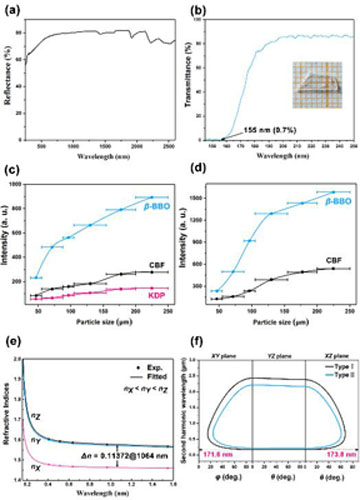As the key devices of the deep-ultraviolet (DUV, wavelength below 200 nm) all-solid-state lasers, DUV nonlinear optical (NLO) crystals have attracted increasing attention in the near decades.
KBe2BO3F2 (KBBF) is the unique crystal that can directly generate the sixth harmonic laser of Nd: YAG lasers (wavelength = 177.3 nm). Though the optical performances of KBBF crystal are excellent, its intrinsic drawbacks like toxicity and layered growth habit limit the commercial applications. Thus, the design and synthesis of new DUV NLO crystal is of urgent demand.
A research group led by Prof. Pan Shilie at Xinjiang Technical Institute of Physics and Chemistry of Chinese Academy of Sciences have successfully designed a new DUV NLO crystal CsB4O6F (CBF) by combining the superior functional units of B3O6 in β-BBO and BeO3F in KBBF with the replacement of Be by B. The study wpublished in Angew. Chem. Int. Ed.
The combination and modification of known functional units is an effective approach for designing new DUV NLO crystal. As is known to all, the B3O6 units in β-BBO possess the largest nonlinear coefficients in B-O units, however, it suffers from a narrow band gap caused by the dangling bonds.
The newly designed CBF both overcome the demerits of the dangling bonds in β-BBO and the toxicity in KBBF. Thus, its DUV cutoff edge is extended to 155 nm and drastically shorter than BBO (187 nm). And it features a large NLO response (1.9 × KDP, KBBF is about 1.2 × KDP), which is in favor of the laser conversion efficiency.
It also exhibits suitable birefringence to ensure the shortest phase-matching second-harmonic wavelength down to the DUV region (∼171.6 nm). For now, the capability that can be phase-matchable lower than 177.3 nm is very rare for NLO crystals.
In addition, as a beryllium-free crystal, CBF is more environment friendly and safety in the growth process. According to the comparison, CBF has a more compact structure than KBBF. Also, it melts congruently, enabling the facile growth of large single crystals.
These merits make CBF become a very promising candidate for the DUV laser output.
The work was supported by China’s Ministry of Science, National Science Foundation and Chinese Academy of Sciences.

Figure:Linear and nonlinear optical properties of CBF(Image by XTIPC)
Contact:
Prof. PAN Shilie
E-mail:slpan@ms.xjb.ac.cn
Xinjiang Technical Institute of Physics & Chemistry, CAS
